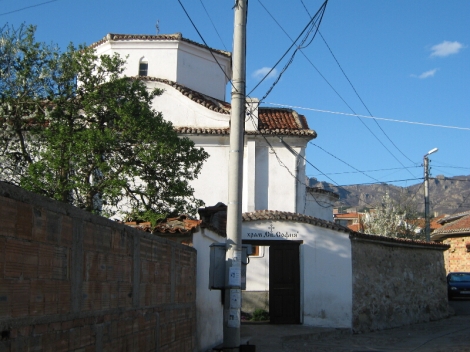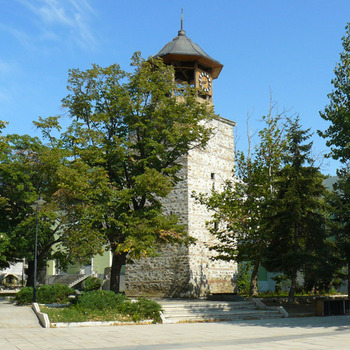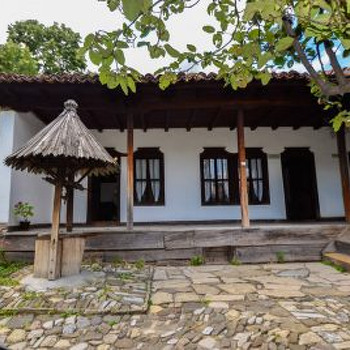Church of St. Sophia Sliven town
Overview
The Church of St. Sophia in Sliven is really the oldest church in the city. The temple is located in the oldest district of Sliven "Novo Selo". Local legend has it that this temple was built since the time of Emperor Justinian the Great in the 6th century. In 2001, the well-known historian, artist and theologian Georgi Todorov wrote the book The Sliven Church of St. Sophia - Wisdom of God. He is adamant that the church "St. Sophia" was built in the thirteenth century and not in the sixth century and was restored in 1836 by Protomaster Petko Petrov from Bratsigovo. During its centuries-long existence, the temple has experienced many critical situations. In the yard of the church is the old cell school, where the teacher Dobri Chintulov taught. The building is a cultural monument.
Ancient artifacts built into the walls of the church of St. Sophia testify to the early origin of the church, which according to some hypotheses dates back to the 6th century. Among them are a unique stone antimins, a frieze depicting a cherub, a liturgical vessel and more. According to the book "An Attempt at the History of the City of Sliven" by Dr. Simeon Tabakov, the church dates from the 6th century, and he compares it with the so-called Sophia temples built by Emperor Justinian the Great. There were such in Constantinople, Sofia, Thessaloniki, Ohrid. Sophia's temples were built and named after God's wisdom Sofia or the incarnate Son of God Jesus Christ, not the saint-martyr Sophia and her three daughters. The temples of St. Sophia are in fact temples of Christ.
During the renovation in 1836 in the Sliven "St. Sophia" were found many things walled up in the walls. These shrines also show the early origin of this temple. One of them is a frieze with a cherub built into the western part of the church, which is currently stored in the art gallery. The other find is a stone antimins / literally means instead of a table and the holy liturgy is performed on it, as in ancient times it was made of stone or wood, and in modern times it is made of flax /. The antimins was built into the dome of the temple in a special niche, where it looked like part of a window. The subject is from the early centuries of Christianity and does not know if there is another like it in the country. According to Dr. Tabakov's book, the church also has a marble slab with an inscription from tsarist times. According to the priest, this would be an infinitely valuable find and he hopes it will be discovered.
In the yard of the church, in addition to the church, which is a cultural monument, is the first school in Sliven, which was part of the church board. There, the mutual teaching method was taught, according to which the older and more advanced students teach the younger ones. The idea of such a method is to develop leaders.
Experts from the Historical Museum in Sliven have come to the conclusion that the school is from 1847 - 1850. Photos from the school archives show that it is older. Another hypothesis states that the temple was built in the 13th century. However, according to the research of Mary Radeva from the Sliven Historical Museum, the eastern part of the church was built on the northeastern part of the apse of an old church, probably demolished during the Second Bulgarian Kingdom. This means that the current temple is much smaller than the previous one, and it really was the size of the old temples of Justinian the Great.
At the end of the 19th century, the spread of heresy, called Sophia's heresy, began. It originates from Russian theologians abroad, who began to think of the Wisdom / Sophia / as the fourth incarnation / essence / of God, or the feminine principle. This heresy was refuted by Bishop Seraphim Sobolev, who lived in Bulgaria for a long time. Then in the temples the holidays begin to be duplicated, and besides Sophia's Day or the Feast of God's Wisdom, it is also celebrated on September 17 - the Day of St. martyr Sofia and her three daughters. Another argument for the antiquity of the Sliven temple is the celebration of the second temple holiday. Apart from September 17, the Day of St. Sophia and her three daughters, the church celebrates the second week after Easter. Only in Sliven the holiday is celebrated on Monday of Tomina Sunday or eight days after Easter. Dr. Simeon Tabakov also spoke about this, testifying that this Sofinden has been celebrated since ancient times. St. Sophia in Sliven was the only church that kept its worship during the Turkish slavery, when there was no development of Bulgarian theology and everything was done according to legend. The church in Sliven was the only one in the area / Byzantium, Bulgaria, Macedonia and Serbia / that was not turned into a mosque.
Recommended
- Sliven Art Gallery
- Hadji Dimitar House Museum
- Dobri Chintulov House-Museum
- National Museum of the Textile Industry
- Tuida Fortress and others


 Bulgarian
Bulgarian Romanian
Romanian


